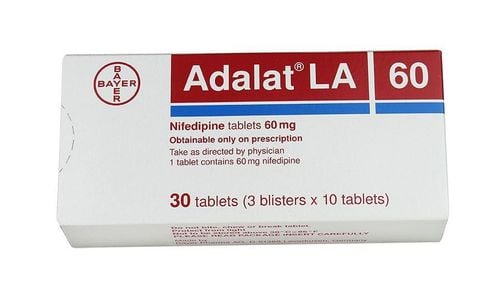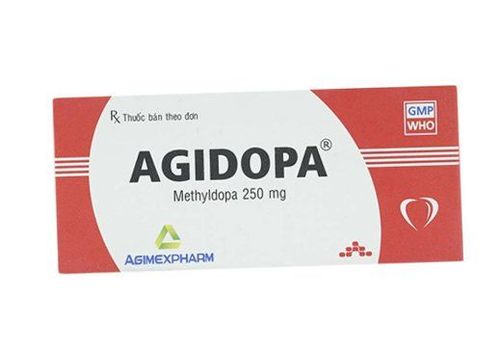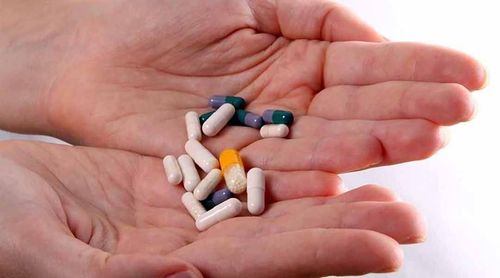This is an automatically translated article.
Currently there are many different antihypertensive drugs, one of the most commonly used drugs is Savi Losartan 100 or Savi Losartan 50, manufactured by SaviPharm Company. The drug Savi Losartan works quickly in effectively controlling blood pressure, helping to stabilize the patient's health.
1. What is Savi Losartan?
Savi Losartan is a drug containing the main ingredient, Losartan, with different strengths: Savi Losartan 100 mg and Savi Losartan 50 mg. Savi Losartan is produced in the form of round, film-coated blue tablets, two meniscus, one smooth side, one side dashed.
Losartan is the first of a new class of antihypertensive drugs. It is an angiotensin II (AT1) receptor antagonist, which is formed from angiotensin I in an angiotensin-converting enzyme-catalyzed reaction and is a potent vasoconstrictor; This is a hormone that activates the vessels of the renin-angiotensin system and is an important component in the pathophysiology of hypertension, in addition, Angiotensin II also stimulates the adrenal cortex to secrete aldosterone.
Losartan and its major active metabolite block the vasoconstrictor and aldosterone-secreting effects of angiotensin by selectively blocking angiotensin II from binding to the AT1 receptor present in many tissues (eg. in vascular smooth muscle, adrenal gland). Neither losartan nor its major metabolite exhibits local agonist activity at the AT1 receptor and has a much greater affinity for the AT1 receptor (approximately 1000-fold) than for the AT2 receptor.
Losartan competitively inhibits the AT1 receptor and the active metabolite of Losartan is 10 to 40 times more potent than losartan, by weight and is a noncompetitive, favorable inhibitor. inverse of the AT1 receptor. Angiotensin antagonists also exhibit hemodynamic effects similar to ACE inhibitors, but without the common undesirable effect of ACE inhibitors, namely dry cough.
2. Effects of the drug Savi Losartan
Savi Losartan 100 mg or Savi Losartan 50 mg is indicated for use in the following cases:
Treatment of hypertension in adults and children 6 years of age and older: As monotherapy or in combination with antihypertensive drugs other hypertension (thiazide diuretics), use Losartan in patients intolerant of ACE inhibitors; The effect of the drug Savi Losartan is to treat heart failure; Treatment of kidney disease in people with hypertension and diabetes, with proteinuria > 0.5g/day; The effect of Savi Losartan in reducing the risk of stroke in hypertensive patients with left ventricular hypertrophy.
3. What is the dose of Savi Losartan?
Savi Losartan 100 mg or Savi Losartan 50 mg can be taken orally, with or without food.
3.1. Dosage of Savi Losartan in the Treatment of Hypertension The initial and maintenance dose of Savi Losartan is usually 50 mg of Losartan once daily. The greatest antihypertensive effect is usually achieved after 3 to 6 weeks of treatment with Savi Losartan. In some patients, the dose of Savi Losartan can be increased up to 100 mg/day and no dose change is required in patients with renal impairment, including those undergoing hemodialysis. If Savi Losartan alone does not control blood pressure, the doctor may prescribe a low-dose diuretic. Hydrochlorothiazide usually has an synergistic effect with Savi Losartan or Losartan can be used with other antihypertensive agents. Do not combine Savi Losartan with potassium-sparing diuretics due to the risk of hyperkalemia.
3.2. Savi Losartan is indicated for the treatment of renal disease in hypertensive patients with diabetes mellitus and proteinuria >0.5 g/day The initial dose of Savi Losartan is usually 50 mg of Losartan once daily or the dose may be increased up to Savi Losartan. 100 mg/day based on the patient's response or in combination with other antihypertensive agents (diuretics, calcium blockers, α-blockers, β-blockers...), insulin or other hypoglycemic agents. other oral tablets (sulfonylureas, glitazone, glucosidase inhibitors).
3.3. Savi Losartan Treatment of Heart Failure The initial dose of Savi Losartan is usually 12.5 mg of Losartan once daily, increased gradually weekly and the maximum dose is 150 mg Losartan/day.
3.4. Savi Losartan reduces stroke risk in hypertensive patients with left ventricular hypertrophy low dose combination of Savi Losartan and hydrochlorothiazide.
3.5. Savi Losartan in Children Under 6 Years The safety and effectiveness of Savi Losartan have not been established in children under 6 years of age, therefore the use of Savi Losartan in children under 6 years of age is not recommended.
3.6. Savi Losartan for children 6 years of age and older Children 20 - 50 kg, the recommended dose of Savi Losartan is 25 mg, 1 time / day, up to a maximum of 50 mg, 1 time / day depending on the child's response. Children 50 kg or more, the usual dose of Savi Losartan is 50 mg, 1 time / day, up to a maximum of 100 mg, 1 time / day. Doses of Savi Losartan above 1.4 mg/kg body weight/day (approximately 100 mg/day) have not been studied in children; The use of Savi Losartan 100 is not recommended for children with glomerular filtration rate < 30 ml/min/1.73 m2 or children with hepatic impairment. 3.7. Savi Losartan in volume-depleted patients taking high-dose diuretics The recommended starting dose of Savi Losartan is 25 mg Losartan once daily.
3.8. Savi Losartan in patients with renal failure or on hemodialysis No dose adjustment of Savi Losartan is required.
3.9. Savi Losartan in patients with hepatic impairment The dose of Savi Losartan should be reduced in patients with hepatic impairment. Do not prescribe Savi Losartan in patients with severe hepatic impairment.
3.10. Savi Losartan for People over 75 years The recommended starting dose of Savi Losartan is 25 mg of Losartan once daily, however in most cases in the elderly over 75 years no dose adjustment of Savi Losartan is required.
4. Side effects of Savi Losartan
When using Savi Losartan 100 mg or 50 mg, patients may experience unwanted effects such as:
4.1. Common side effects of Savi Losartan Cardiovascular: Lower blood pressure, chest pain; Central nervous system: Insomnia, dizziness, fatigue; Endocrine - metabolic: Hyperkalemia, hypoglycemia; Digestion: Diarrhea, dyspepsia; Hematology: Mild decrease in hemoglobin and hematocrit; Neuromuscular - skeletal: Back pain, leg pain, muscle pain; Kidney: Hypouricemia (in high doses), urinary tract infection; Respiratory: Cough (less than ACE), nasal congestion, sinusitis. 4.2. Uncommon side effects of Savi Losartan Cardiovascular: Grade II AV block, sinus bradycardia, tachycardia, facial edema, flushing; Central nervous system: Anxiety, confusion, depression, migraine, sleep disturbance, fever, dizziness; Skin: Alopecia, inflammation, dryness, erythema, photosensitivity, pruritus, urticaria, bruising, rash; Endocrine-metabolic: gout. Digestive: Anorexia, constipation, flatulence, loss of taste, gastritis; Genitourinary - urinary: Impotence, polyuria, nocturia; Liver: Slight increase in liver function indicators and slight increase in bilirubin; Neuromusculoskeletal: Paresthesia, tremor, muscle weakness, joint edema, myalgia; Eyes: Blurred vision, conjunctivitis, burning and stinging eyes; Ears: Tinnitus; Kidney: Urinary tract infection, increased creatinine or urea; Respiratory: Shortness of breath, bronchitis, nosebleeds, rhinitis, airway congestion; Other effects: Sweating.
5. In which cases is Savi Losartan contraindicated?
Hypersensitivity to Losartan or other components of the drug Savi Losartan; Pregnant; Severe liver failure; Diabetes or renal failure (glomerular filtration rate < 60 ml/min/1.73 m2) being treated with antihypertensive drugs containing aliskiren.
6. Precautions while using Savi Losartan
Special monitoring and/or dose reduction of Savi Losartan is required in patients with dehydration, diuretics and those with predisposing factors for hypotension; Patients with bilateral or unilateral renal artery stenosis, who have only 1 kidney left, are also at high risk of unwanted effects of Savi Losartan (increased creatinine and blood urea), should be closely monitored in treatment.; Due to the risk of hyperkalemia, it is necessary to monitor blood potassium levels in the elderly and in patients with renal impairment, do not use Savi Losartan with potassium-sparing diuretics; Patients with liver failure must use a lower dose of Savi Losartan; Due to the presence of lactose in the preparation Savi Losartan, patients with hereditary problems such as galactose intolerance, fructose intolerance due to Lapp-lactase deficiency, glucose-galactose malabsorption may experience symptoms. lactose intolerance should not prescribe Savi Losartan; Savi Losartan has side effects causing dizziness, lowering blood pressure, so it should be used with caution when using Losartan for people who need to drive and operate machinery;
7. Savi Losartan Drug Interactions
Losartan does not affect the pharmacokinetics of digoxin administered orally or intravenously; Taking Savi Losartan with cimetidine increased the area under the curve (AUC) of Losartan by about 18%; Co-administration of Savi Losartan with phenobarbital reduced the AUC of Losartan and its active metabolite by approximately 20%; Hyperkalemia occurs when Savi Losartan is co-administered with potassium-sparing diuretics, so potassium supplements or potassium-containing salt substitutes should be used; Rifampicin, aminoglutethimide, carbamazepine, nafcilin, nevirapine, phenytoin, decreased plasma concentrations of Savi Losartan and its metabolite when co-administered; Savi Losartan increases the effect of drugs: Amifostine, antihypertensive drugs, carvedilol, hypoglycemic agents, lithium, potassium-sparing diuretics, rituximab; NSAIDs, including specific COX-2 inhibitors, when used in combination with Savi Losartan can cause renal failure, requiring monitoring of renal function in patients.
Please dial HOTLINE for more information or register for an appointment HERE. Download MyVinmec app to make appointments faster and to manage your bookings easily.













